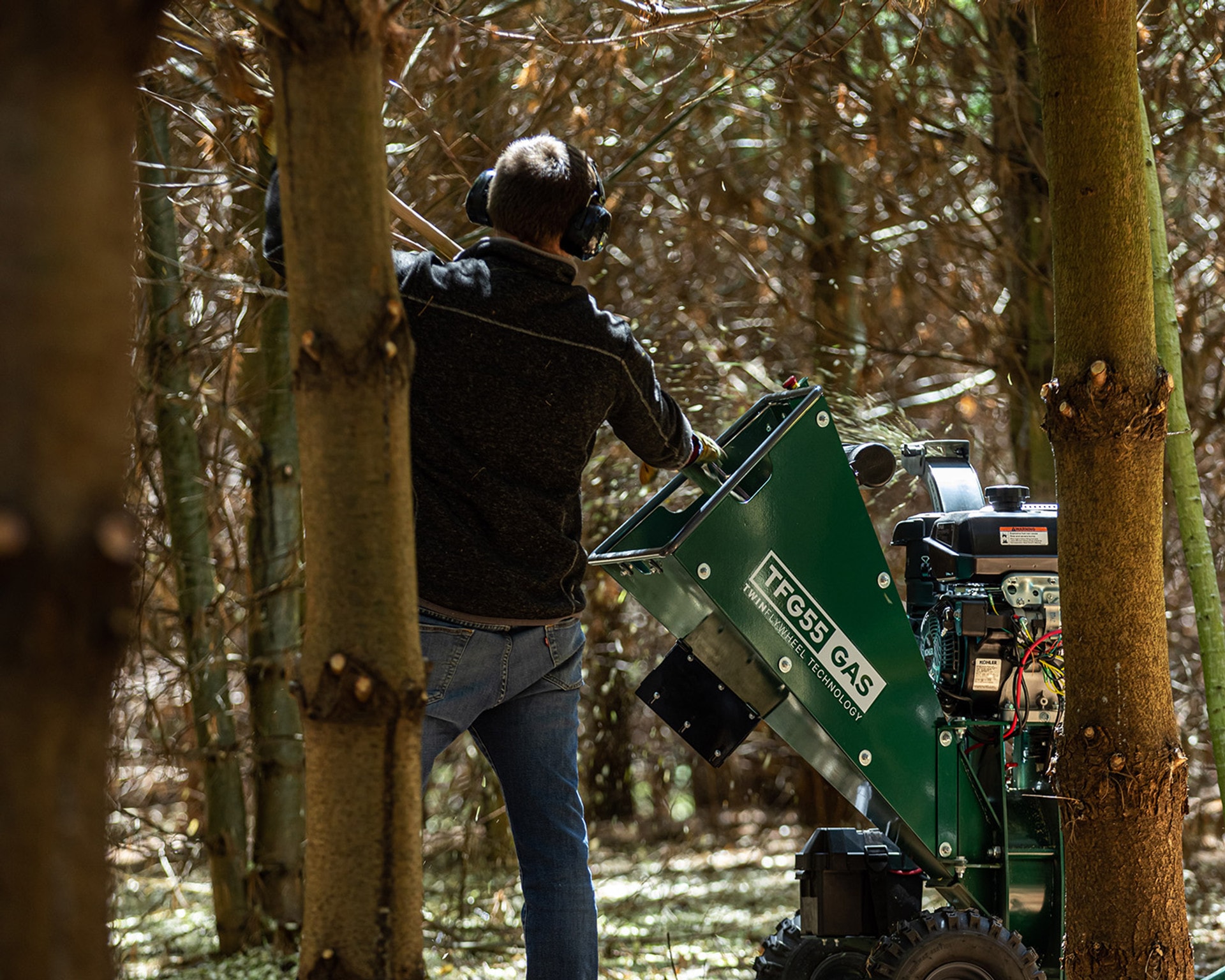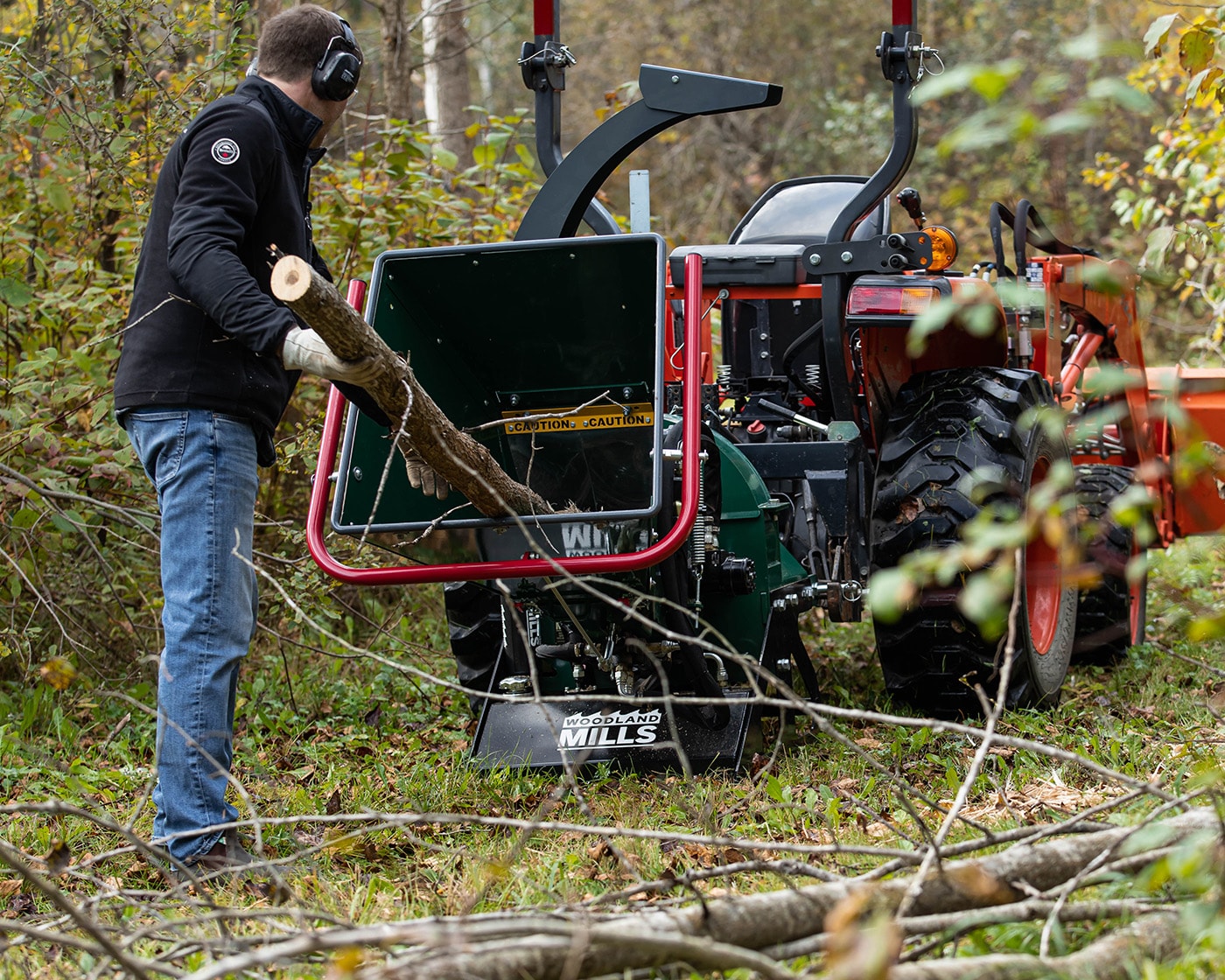Types of wood chippers: A complete buyer's guide
What are the different types of wood chippers and which one is best for making wood chips out of your tree debris?
There are many types of wood chippers on the market, and it should be easy to find the ideal wood chipper for your property maintenance needs.
So with that in mind, what are some of the different types of wood chippers and how does each one turn tree limbs, brush and other foliage into wood chips?
Here is a quick explainer to get you caught up so you can decide which is the best wood chipper for you.
Different types of wood chippers
Wood chippers are a versatile set of machines which can help get rid of garden waste, and here are a few of the types available on the market:
PTO Wood Chippers: These wood chippers rely on your tractor's Power Take Off to supply power. PTO chippers are reliable machines which don't need their own fuel, and can easily be hauled by your tractor across your property.

Gas Wood Chippers: These machines use their own independent engine and are standalone units which don't need a separate machine to function. Put this behind your ATV, or in the back of your truck or trailer and you can move it to wherever you need to do some wood chipping.
Electric Wood Chippers: While there are some exciting developments in the area of electric equipment, wood chippers are not very common, and the batteries and technology required to make them work are still in their infancy.
There are also a few different types of cutting mechanisms for chippers:
Disc Wood Chippers: These wood chippers work by way of a rotating flywheel with blades attached to shred wood material. There is also a subset of disc wood chippers which use Woodland Mills' patented Twin Flywheel technology, where a second flywheel aids the discharging process.
Drum Wood Chippers: These wood chippers feature a rotating drum with blades on the inside, so material falls into the drum and is chipped. Drum chippers tumble the material until its been turned into wood chips, at which point it's fed out.
Drive Systems for Wood Chippers
There are two common and popular drive systems for wood chippers on the market:
PTO Wood Chippers
Let's dive into PTO chippers so you can decide if they are the right wood chipper for you.
PTO wood chippers are powered by your tractor's Power Take Off. It connects via the PTO shaft, which must be trimmed on your wood chipper to fit the connection on your tractor. PTO chippers:
-
-
Do not need their own fuel
-
The speed of the flywheel is determined by the output of your tractor's engine
-
Can be easily towed by your tractor via its three point hitch
-
PTO wood chippers are very common on rural farm properties, and are popular among people who already own a tractor. Different models of wood chipper are designed for different PTO outputs, so you may need a larger or smaller model depending on the horsepower of your tractor.
These are great tools for those with large properties, but even small lawn tractors are capable of attaching a PTO chipper, and turning small branches and tree foliage into wood chips. Hobby farm owners and owners of large rural acreage alike are able to get the most out of these machines.
Gas Wood Chippers
Gas powered wood chippers are another popular category of wood chippers, and have their own benefits over other kinds of wood chipping machines.
Some of the perks of gas wood chippers include:
-
-
They do not need a separate machine to function
-
They can be hauled on a three-point hitch or on the back of a trailer bed
-
Improved portability over PTO chippers, as they can be attached to ATVs or UTVs
-
Gas wood chippers are effective in turning garden debris and other yard waste into wood chips for your gardens or trails. Because they don't need a tractor, they have increased portability and feature an independent fuel system. They do need a bit more work to prepare and feed materials, but once you've got the flow going they feature a smooth operation that makes the job even easier.
Woodland Mills' TFG55 GAS is one model of gas powered wood chipper, which features a gravity feed system with an angled chute specifically designed to deliver material to the cutting blades smoothly and efficiently, turning your wood quickly into chips.

Infeed Systems
Here are two ways of feeding material into your wood chipper's cutting mechanism.
Hydraulic Infeed
Hydraulic Infeed is a tried and true method of easily pulling branches int your wood chipper. Branches are pulled into chipper by an infeed roller. The roller is hydraulically driven by the chipper's self-contained hydraulic system, and the hydraulic pump is belt driven from the main flywheel shaft. The infeed roller is adjustable in direction and speed, making it easy to feed branches of all shapes and sizes.
The roller down pressure may be adjusted via two large springs, ensuring it grabs branches and easily pulls them in, eliminating the need for manual feeding. Simply push the branch into the feed chute until the roller takes hold of it, then the roller will take charge, pulling the tree branches or other tree limbs into the flywheel for you, converting them into a pile of chips.
In-feed rollers help to:
-
-
Reduce the effort of the user by allowing the machine to pull in the branches
-
Cut down on repetitive motions like bushing branches into the feed chute
-
Make for an easier and simpler experience while wood chipping
-
While not every wood chipper comes with hydraulic in-feed, it can be a very helpful feature. Research the wood chipper that you feel is best for you and see if this is a feature you would like to have on your wood chipper.
Gravity Assist Infeed
Woodland Mills' gravity-fed wood chippers are specifically designed for easy use, so you can safely and swiftly put material into the feed chute and watch as it becomes wood chips before your eyes.
Gravity feed works like this:
-
-
Branches are fed into a steep angled chute, with the slope of the chute specifically designed to create the simplest path for the materials to get to the flywheel
-
A high-torque, slow-speed, three-bladed flywheel is used in combination with the chute to ensure material is chipped efficiently
-
Woodland Mills TFG55 models, which feature Gravity Assist Infeed, also use Twin Flywheel technology, to ensure any leafy material is chipped reliably without needing to mix in heavier material
-
Gravity assist systems are used as an affordable feed system in wood chippers, and although more manual effort is needed to feed material into the feed chute compared to hydraulic rollers, this system is designed to reduce strain and allow gravity and the power of the flywheel to do most of the work.

Which is the best wood chipper?
So which wood chipper should you buy to help eliminate yard waste, getting rid of troublesome brush and even larger branches?
That's going to depend on your needs, but here are a few considerations and recommendations:
-
-
If you are looking for a budget wood chipper, aiming to get rid of brush, branches and leafy green material with the smallest investment, it may be wise to look at a Gravity Infeed wood chipper. You could even save money by buying a PTO-compatible model, though make sure you have a tractor which can power it. If not, look for gas powered wood chippers which also use Gravity Infeed
-
Models like the TFG55 GAS and TFG55 PTO are recommended for this use
-
-
If you have farm equipment, plan on doing semi commercial or industrial use, or live in a rural area with a lot of dense trees with larger branches, you may want to invest in a PTO chipper capable of dealing with thicker material. Hydraulic Infeed rollers will help to feed in material and make for an easier experience for the user. Having a bigger model of chipper with a large disc means you'll have the right machine for turning your many brush piles into useful wood chips.
-
If you want to chip leafier and greener material, you should keep your eyes out for wood chippers which feature Twin Flywheel technology. The mechanics of this system improves the efficiency of chipping and discharging this type of material, and all Woodland Mills PRO models feature Twin Flywheel
-
If you have large volumes of tree branches and other tree debris on your property, and you need it gone, a wood chipper is the best tool to help clean up your property. These heavy duty machines feature robust performance designed to help turn tree material into a useful resource you can use around your property, for light cleanup or land clearing.
And there's lots of different models which suit different needs. If you need more power, or improved portability, there are different types of wood chippers which can help you.
With so many powerful chippers on the market, it can be difficult to make a decision, but picking the right model will ensure optimal performance for cleaning up your property to create uniform chips wherever you need them.
FAQs
What's the best machine for when I need to chip wood quickly?
The best wood chipper is one that maximizes its cutting speed. For PTO wood chippers, that means getting the highest capacity chipper that's compatible with your tractor.
So for example, if you have a tractor with 100 HP at the PTO, it's wise to get the TF810 PRO, which utilizes every bit of your tractor's power to chip wood the fastest.
What's the benefit of the Twin Flywheel chipping mechanism?
Twin Flywheel is Woodland Mills exclusive innovation in the wood chipper market. One flywheel is dedicated to chipping while the other assists in discharging material. It ensures you can reliably chip light, leafy material without needing to mix in heavier material with it.
For the most efficient operation and reliable chipping experience, Twin Flywheel is the way to go.
Are Woodland Mills wood chippers intended for construction sites or residential use?
Both, and much more. With a range of chippers with different capacities, there is a wood chipper available for whatever you need. From hobby farm owners to medium-scale commercial or even large-scale farming operations, advanced features like Twin Flywheel ensure you've got the best chipping technology wherever you go.
SHOP WOOD CHIPPERS
WC46 4" PTO
The WC46 chipper has a chipping diameter up to 4". It's designed for tractors with 15-30 HP at PTO and features an auto-hydraulic infeed system and 360-degree swivel discharge.
WC68 6" PTO
The WC68 chipper has a chipping diameter up to 6". It's designed for tractors with 20-50 HP at PTO and features an auto-hydraulic infeed system and 360-degree swivel discharge.
WC88 8" PTO
The WC88 chipper has a chipping diameter up to 8". It's designed for tractors with 35-100+ HP at PTO and features heavy-duty construction and an auto-hydraulic infeed system.
TF810 PRO PTO
The TF810 PRO chipper features our patented Twin Flywheel Technology. Designed for tractors with 35-100+ HP at PTO, it has a chipping diameter up to 8" and auto-hydraulic infeed system.
Join the Woodland Mills Community Facebook group. Search advice and insights from over 65,000 knowledgeable, supportive members.
- Pre-purchase considerations
- Sawmill set-up support
- Project inspiration photos and videos
- Community troubleshooting support
